MacGregor Historic Games Rose & Pentagram Design
2229 East 34th Street, Minneapolis, Minnesota 55407
| Ancient lathes | Continual rotation lathes | Spring-pole lathes |
| Bow lathes | Tools | Related Machines |
| Specialty Lathes | Quotes about turning | Notes on a 17th Cent. turner |
| My bow lathe | Bibliography | Links |
Two early examples of Spring Pole Lathes. The left-hand illustration is base don a Parisian manuscript dating from the mid-13th century. Scanned from Daumas' A History of Technology & Invention Vol. I.
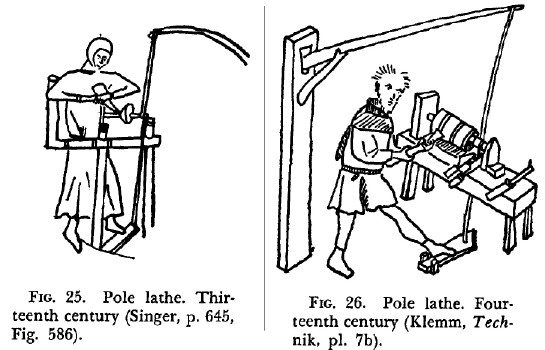
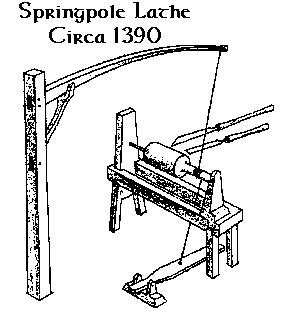
Of the Pole...
The Pole is commonly made of a Fir-pole, and is longer, or shirter, or bigger or smaller, according to the weight of the Work the Workman designs to Turn : for the thicker the pole is, the harder must the tread be to be to bring it down; and for this reason, if the Pole prove too strong for their common or continued Work, they will weaken it by cutting away (with a draw knife) part of the substance off the upper and under side of the pole.
The thick end of this Pole is nailed (or indeed rather pinned) up to some girder, or other Timber in the Ceiling of the Room, with a single Nail or Pin, that the Pole may move upon that Nail. -Joseph Moxon.
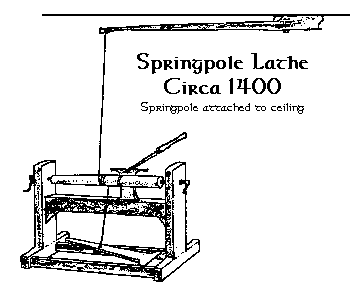
Scanned from Country Furniture, by Aldren A Watson.
On the String on a Spring-pole Lathe
"Upon the thin end of the pole is ound a considerable bundle of string, that as a mandrel requires to be bigger than ordinary, or the wokr heavier, they may unwind so much if the string as will compass the mandrel twice, or (if the work be heavy) thrice; the easier to carry it about.
This string is made of the guts of beasts (most commonly of sheep, and spun round of several thicknesses, of which the workman chuses such sizes as are aptest for his work; for large and heavy work, very thick, but for small and light work, thin..." -Joseph Moxon.
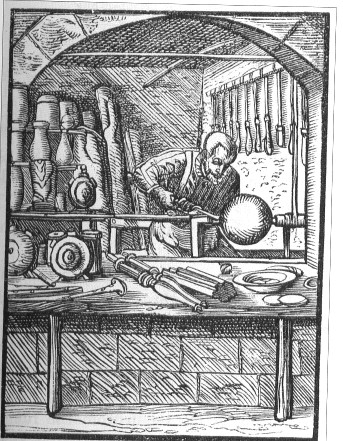 16th Century Turning Shop
16th Century Turning Shop
A turner working a making a sphere using a spring-pole lathe in a woodcut from Panoplia Omnium (1568), by Hartman Shopper. Scanned from M. Darlow's Woodturning Technicques
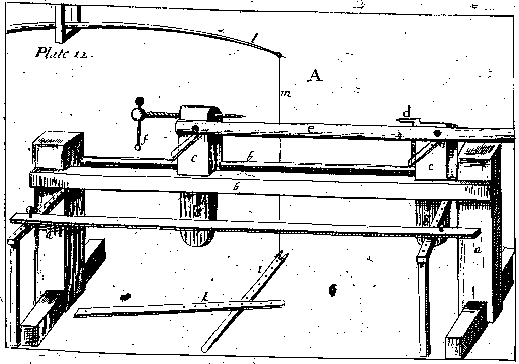 Spring pole lathe
Spring pole lathe
from Joseph Moxon's Machanick Exercises, 1680.
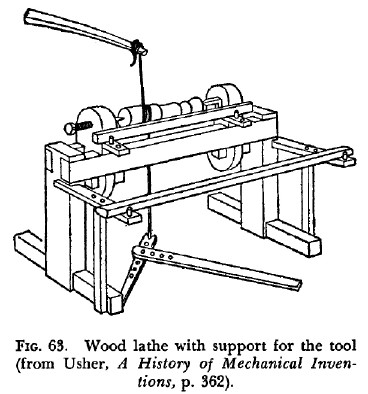 Another view of a Spring-pole lathe showing a better view of the tool rest and turner's seat/bench both of which seem to be adjutable on pegs. The bench was used for support by leaning against it, not actually for sitting. Daumas in his History of Technology & Invention suggests that the toolrest does not appear on lathes until the end of the 15th, or middle of the 16th century.
Another view of a Spring-pole lathe showing a better view of the tool rest and turner's seat/bench both of which seem to be adjutable on pegs. The bench was used for support by leaning against it, not actually for sitting. Daumas in his History of Technology & Invention suggests that the toolrest does not appear on lathes until the end of the 15th, or middle of the 16th century.
Scanned from Daumas' A History of Technology & Invention Vol. II
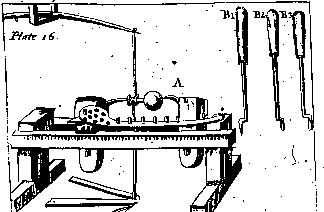 A Metal Turning Lathe using a spring pole.
A Metal Turning Lathe using a spring pole.
Scanned from Moxon's Machanick Exercises
"Brasiers that Turn Andirons, Pots Kettle, &c. have their Lathe made different from the Common Turners LAthe, as you may see in Plate 16. at A, where the Cheeks, Puppets and Rests, &c. are mujch stronger and the Pikes stronger and longer than those common Turners use... And as the common Turners work with a round string made of Gut, as hath been described... The Brasiers work with a Flat Leather Thong, which wrapping close and tight about the Rowler of their Mandrel, commands it the easier and more forcibly about... " Source: Joseph Moxon's Machanick Exercises. Moxon also goes on to describe how the tools have a double bend in them to brace them against the tool rest for more leverage, and that iron pegs in the tool rest provide additional support to the tool.
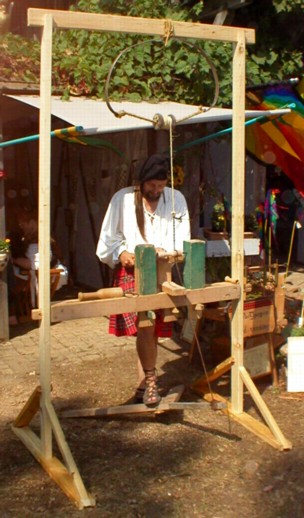 One of my shop assistants working my foot-powered lathe
One of my shop assistants working my foot-powered latheIn front of our booth at the Minnesota Renaissance Festival. It uses a bow instead of a spring pole. The metal bow was a spring that was scavenged from an antique baby buggy. I originally tied the cord directly to the bow string, but the bow was too stiff for me to work with for very long, so I added a pulley to the bow string following an example portayed in one of Roy Underhill's wood wright's books.
"Some turners that work light work, such as cane-heads, ink-horns, &c. for which they need scarce remove the Puppets off their Lathe, use a common Bow, such as Archers use. The middle of this Bow the fasten over Head, with its string Horizontally downwards, and in the middle of of that String the fasten another String perpendicularly downwards, whose other end the fasten to the Treddle, and the String wound round their Work brings it around" -Joseph Moxon on using a bow for a spring.
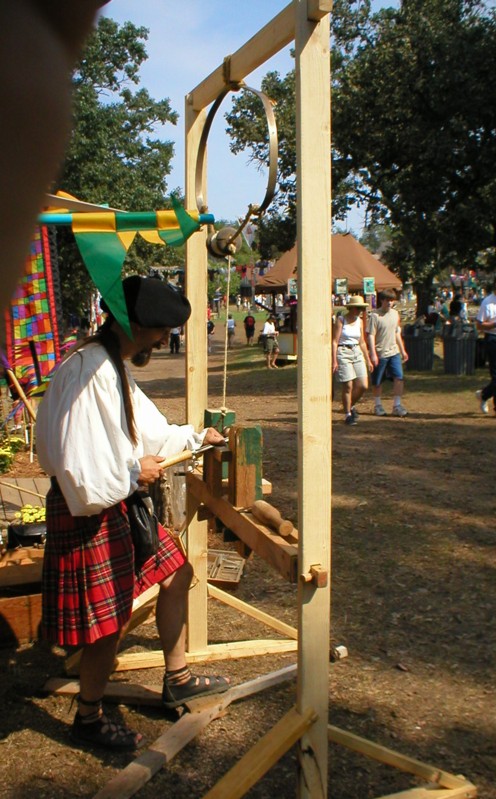 The Bed and framework is entirely pegged togther, the only screws are in the treadle where I cheated a little to repair it after the pegs started coming loose.
The Bed and framework is entirely pegged togther, the only screws are in the treadle where I cheated a little to repair it after the pegs started coming loose.